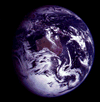Earth
 Earth is the only terrestrial planet whose name was not received
by Greek mythology. Earth is instead of English/German origin. Earth is
the only planet where life has definitely been detected (the jury
is still out on Mars!). Large quantities of both oxygen and water are
present, in fact over 70% of the Earth's surface is covered with water.
Beneath the surface, Earth is known to have a large core, most likely
made up of iron. At the centre of the core, temperatures may reach as
high as 7750°C, hotter than the surface of the Sun. The existence
of this core, and Earth's many other layers, particularly the mantle,
make it the densest major body in our Solar System.
Earth is the only terrestrial planet whose name was not received
by Greek mythology. Earth is instead of English/German origin. Earth is
the only planet where life has definitely been detected (the jury
is still out on Mars!). Large quantities of both oxygen and water are
present, in fact over 70% of the Earth's surface is covered with water.
Beneath the surface, Earth is known to have a large core, most likely
made up of iron. At the centre of the core, temperatures may reach as
high as 7750°C, hotter than the surface of the Sun. The existence
of this core, and Earth's many other layers, particularly the mantle,
make it the densest major body in our Solar System.
|
Diameter |
12, 756 km |
|
Mass |
5.97 × 1024 kg |
|
Mean Distance from sun |
149,600,000 km |
|
Mean Density |
5.52 g/cm3 |
|
Rotational Period |
1 Earth day |
|
Orbital Period |
365 Earth days |
|
Mean Orbital Velocity |
29.78 km/s |
|
Atmosphere |
79% Nitrogen, 21% Oxygen |
|
Average Surface Temperature |
14°C |
|
Equatorial Surface Gravity |
9.78 m/s2 |
| Copyright owned by the State of Victoria (Department of Education and Early Childhood Development). Used with Permission. |
|
|||||||||||||||||||||||||||||||||||||||||||||||||||||||||||||||||||||||||||||||||||||